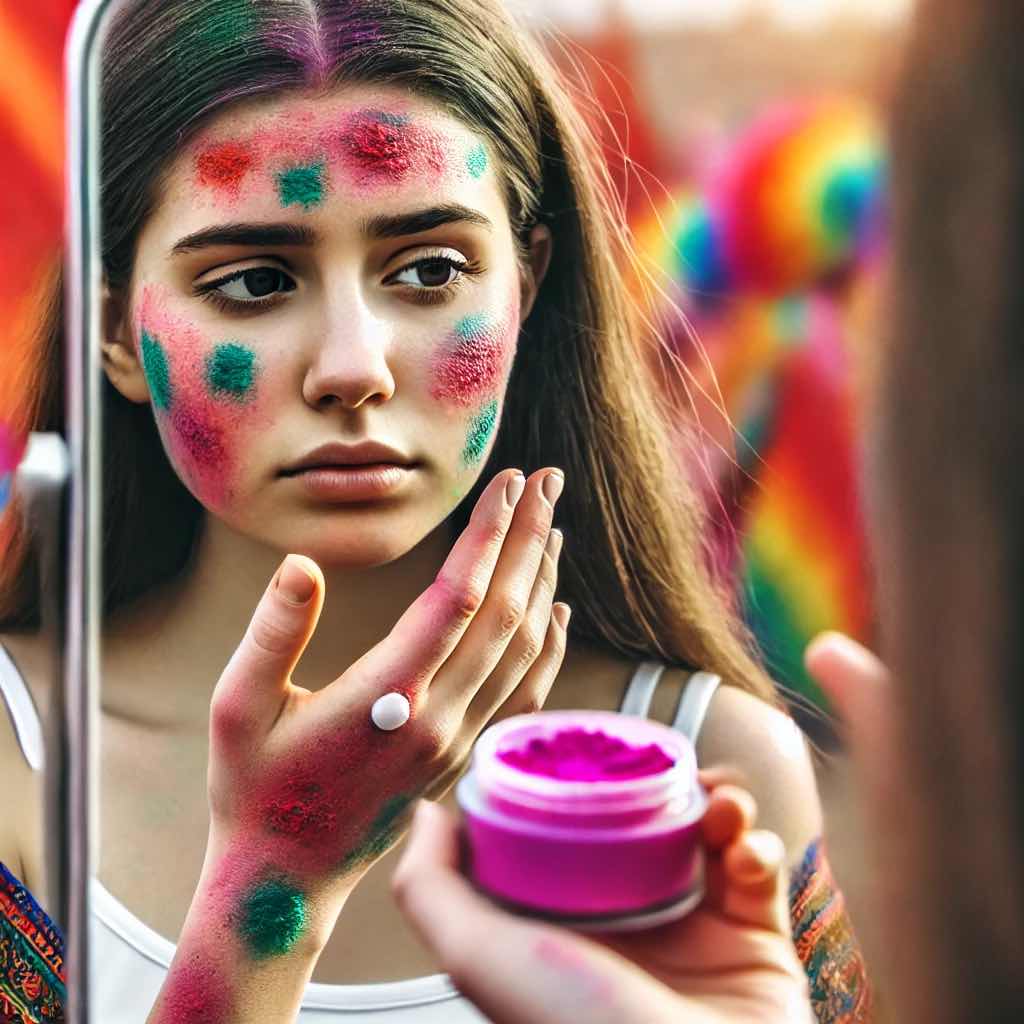Introduction
Festivals like Holi, La Tomatina, and Carnival bring joy, but they can also cause skin infections due to chemical-based colors, bacteria, and prolonged exposure to moisture. Many people experience rashes, itching, acne flare-ups, fungal infections, and allergic reactions after celebrating.
In this article, we’ll explore the common skin infections from color festivals, their causes, prevention tips, and the best medicines and home remedies to treat them.
Common Skin Infections from Holi and Other Colour Festivals
1. Contact Dermatitis (Allergic Reaction)
• Symptoms: Red, itchy, inflamed skin with a burning sensation.
• Cause: Harsh synthetic dyes in Holi colors trigger allergic reactions.
2. Fungal Infections
• Symptoms: Red, itchy patches, peeling skin, and sometimes white, scaly lesions.
• Cause: Moist colors create a perfect environment for fungal growth.
3. Bacterial Infections (Folliculitis, Impetigo, Cellulitis)
• Symptoms: Red pimples, pus-filled boils, or painful swelling.
• Cause: Dirty hands and contaminated colors introduce bacteria into hair follicles or cuts.
4. Acne Breakouts
• Symptoms: Increased pimples, blackheads, and whiteheads.
• Cause: Oily colors clog pores, triggering acne flare-ups.
5. Sunburn and Photodermatitis
• Symptoms: Redness, blisters, and peeling skin.
• Cause: Harsh chemicals in colors react with sunlight, causing severe sunburns.
Prevention Tips: How to Protect Your Skin During Color Festivals
✅ Before Playing Holi or Any Color Festival
✔ Apply a thick layer of coconut oil, olive oil, or moisturizer to create a barrier.
✔ Use a sunscreen (SPF 30+) to prevent sun damage.
✔ Wear full-sleeved clothes to reduce direct contact.
✔ Choose organic, herbal, or natural colors to avoid harsh chemicals.
✅ While Playing with Colors
✔ Avoid harsh synthetic colors that contain lead, mercury, and heavy metals.
✔ Do not rub colors aggressively on the skin.
✔ Stay hydrated to prevent excessive dryness.
✅ After the Festival: Proper Skin Care
✔ Wash off colors immediately with mild soap and lukewarm water.
✔ Use aloe vera gel or calamine lotion for soothing irritation.
✔ Avoid scrubbing hard, as it can worsen rashes and acne.
Best Medicines & Home Remedies for Skin Infections After Holi
1. Antihistamines (For Allergic Reactions & Rashes)
Drugs:
• Cetirizine (Zyrtec) – Relieves itching and redness.
• Loratadine (Claritin) – Reduces allergic swelling.
• Fexofenadine (Allegra) – Controls severe allergic reactions.
2. Antifungal Creams (For Fungal Infections & Ringworm)
Drugs:
• Clotrimazole (Canesten, Lotrimin) – Effective for ringworm & yeast infections.
• Ketoconazole (Nizoral) – Treats fungal rashes & athlete’s foot.
• Terbinafine (Lamisil) – Strong antifungal for stubborn infections.
3. Antibiotic Creams (For Bacterial Infections & Boils)
Drugs:
• Mupirocin (Bactroban) – Kills bacteria in infected wounds.
• Neosporin – Prevents and treats minor cuts & infections.
• Fusidic Acid (Fucidin) – Treats impetigo & folliculitis.
4. Acne Medications (For Holi-Induced Pimples)
Drugs:
• Benzoyl Peroxide (Clearasil) – Kills acne-causing bacteria.
• Salicylic Acid (Neutrogena, Clean & Clear) – Unclogs pores & removes dead skin.
• Adapalene (Differin) – Prevents new pimples.
5. Soothing Home Remedies
✔ Aloe Vera Gel – Cools the skin & heals rashes.
✔ Coconut Oil – Moisturizes dry, damaged skin.
✔ Turmeric Paste – Natural antibacterial for wounds & acne.
✔ Yogurt & Honey Mask – Soothes irritation & hydrates skin.
When to See a Doctor?
👉 If rashes, itching, or swelling last more than 3 days.
👉 If blisters or pus-filled boils develop.
👉 If you experience severe burning, fever, or spreading redness.
Conclusion
Holi and other color festivals are fun, but skin infections can ruin the experience. Using organic colors, protecting your skin, and taking quick action if problems arise can help you enjoy the festival without side effects.
If you experience persistent irritation or infection, consult a dermatologist for the right medicines and skincare routine.
Sources & Acknowledgments
This article is based on data from reputable sources, including:
- ClinicalTrials.gov – Providing the latest clinical trial information.
- OpenFDA – Offering reliable drug and medical device data.
We ensure all information is accurate, up-to-date, and aligned with expert-reviewed medical sources. Always consult a healthcare professional for medical advice.
